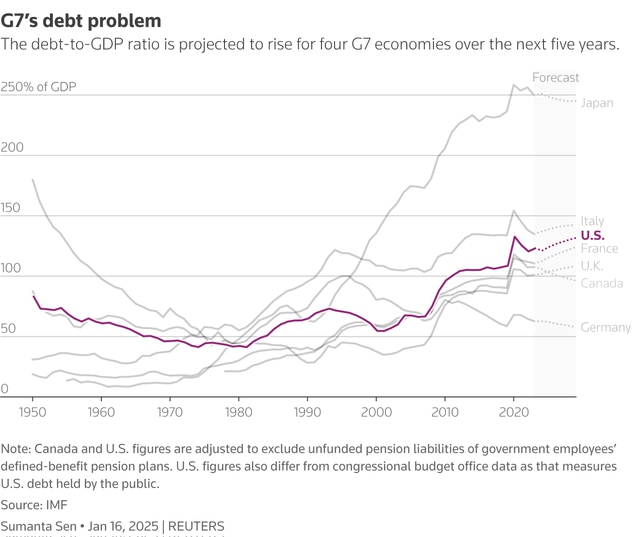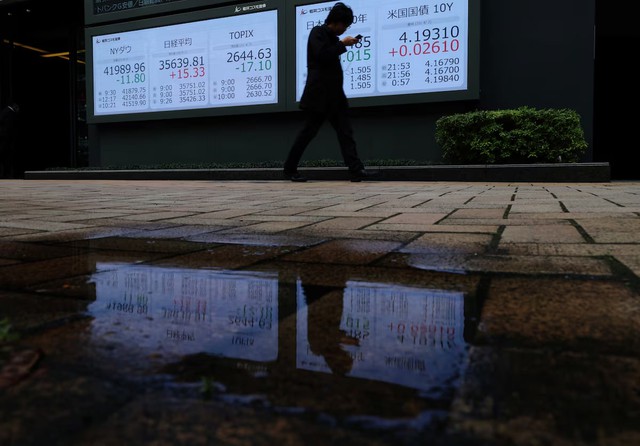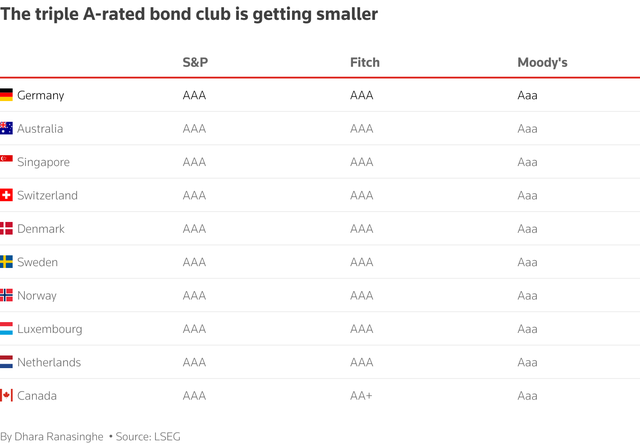UK 30-year gilt yields have hit their highest since the late 1990s this year. U.S. 30-year yields are at 5.09%, up 70 basis points since March.
U.S. public debt is around 100% of gross domestic product and projected to rise to 134% over the next decade, according to Moody's.
The root reason for the selling is what investors call the "term premium", or the extra yield bondholders expect for locking in their money for a long time.
The term premium on 10-year U.S. Treasuries, the extra returns investors demand for holding longer-term bonds rather than rolling over short-term debt, is estimated at 0.79%. That seems too low in this environment - below levels in 2011, when U.S. debt was at similar levels, and a fraction of the 5% during the stagflation of the 1970s.
"People are repricing term premia. It's the sort of concern that stews in the back of your mind but doesn't become a problem until it is," said Rong Ren Goh, a portfolio manager in the fixed income team at Eastspring Investments.
Goh said he had planned to buy longer U.S. Treasuries to add duration to his portfolio should 10-year yields cross 4.5% and 30-year hit 5%, but changed his mind after this week's developments on the U.S. budget bill and Moody's downgrade.
"The process of price discovery, given we are in uncharted territory, may take a while so I would not rush into duration plays at current levels," he said.
Trial and error
Total outstanding U.S. federal government debt was $36.2 trillion at the end of 2024. A little more than $9 trillion is held by foreigners as of March, with Japan accounting for $1.1 trillion of that sum and China $965 billion.
Foreign participation, which includes central banks, in the most recent 30-year Treasury auction was the lowest since 2019, at just 58.88% and it has been tailing off since October.
Japanese investors have been dumping longer-end Treasuries and JGBs, whose yields spiked to record highs this week. They too have demanded better yields at recent auctions.
"The bigger picture is that deficits do matter, and fiscal policy matters, and fiscal space is finite," said Robin Brooks, a senior fellow at the Brookings Institution. "And it's not just the United States that has a fiscal policy problem."
In Japan, bond market concerns stem from the fiscal stimulus lawmakers have planned ahead of an upper house election slated for July, which could mean more government borrowing at a time the Bank of Japan is also reducing its purchases of bonds.
That has stirred the same questions around term premium. Ten-year yields at 1.55% are up 44 bps since early April, moving further away from the BOJ's 0.5% policy rate.
"People expect the BOJ will continue to raise rates and reduce holdings of JGBs", said Masayuki Kichikawa, chief macro strategist at Sumitomo Mitsui DS Asset Management, Tokyo.
"Many investors are probably thinking, especially for super-long bonds, what yield level is consistent with a policy rate at, for example, 1.25% and no support from BOJ buying. We are in a process of finding that equilibrium. It's a process of trial and error."

A story on the bond market and Donald Trump. Line chart showing the annual general government debt to GDP ratio of G7 member countries
Germany could emerge as a winner of that process. While its yields have also spiked this year following massive stimulus that signals more borrowing, it remains the only Group of Seven economy with a debt-to-GDP ratio below 100%.
In fact, during a global bond selloff seen in April, investors flocked to German Bunds.
"Despite the (German) spending commitments, debt levels will remain relatively low and growth is likely to be boosted over the longer term," said Zurich's Miller.


